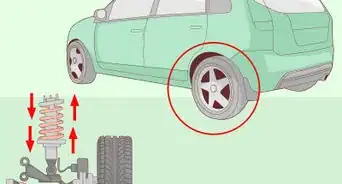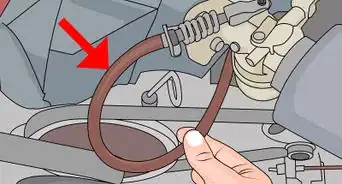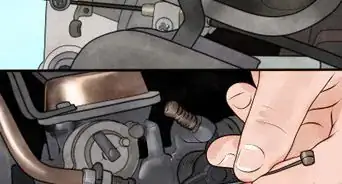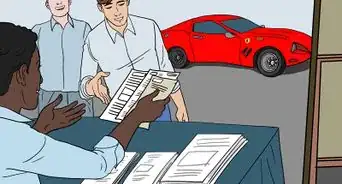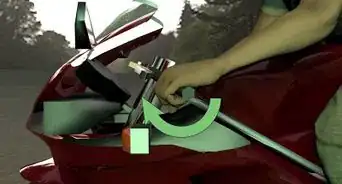X
wikiHow is a “wiki,” similar to Wikipedia, which means that many of our articles are co-written by multiple authors. To create this article, 68 people, some anonymous, worked to edit and improve it over time.
This article has been viewed 370,523 times.
Learn more...
Some people like to take the fast road in life. This article reveals the secrets to racing your car on a track.
Steps
-
1Find a racetrack. Racing your car on public roads is dangerous and illegal. You will also have a lot more fun on a track that is made for speed and safety. Search on the Internet (see "External Links" below) or look in a phone book.
-
2Get schooled. Call the racetrack on the phone and ask when they will be hosting a "Driver's Education" event or when it will be open for the public. You should not race your car until participating in a Driver's Education event. If the track knows of none, search on the Internet for "motorsports clubs" in your area. If you have a car with a racing heritage like Audi, Porsche, BMW, Subaru, etc., search for that club (i.e., Porsche Club of America). When you go to any track, if there is classroom time, avail yourself of the wisdom which will be imparted. Many racers began their careers participating in autocross events. Contact the local NASA (National Auto Sport Association) or do an online search.Advertisement
-
3Perform a safety check. On the day of your first Driver's Education event, check all of the mechanics of your car including oil (which should be topped off), tire pressure (a few PSI higher than normal-ask the instructor or another participant), tire tread, steering fluid, brake fluid and brakes. If you are not experienced in doing a safety check on your car, take it to a mechanic and tell the mechanic you plan on racing the car. When you get to the track, check the tire pressure and oil again. Look under "Things You'll Need" (below) for a list of items to bring to the track.
-
4Learn the rules. Every event has different rules. One common rule is a prohibition on passing, among the most dangerous of racing moments. Find out the rules from the event organizer.
-
5See the track. Feel the track. Be the track. On the track, go around twice at a normal rate of speed to get the lay of the land; if possible, get out and walk the track paying special attention to the turns. Commit the track to memory by drawing it on paper, noting turn-in and track-out points. Do a drive-through with an instructor if at all possible. Don't be scared of the track (AKA: An "O'Gorman"), but give it the proper caution and respect.
-
6Track to curb. When you first go on track at speed, follow an experienced driver. Every turn is approached with a minds-eye view of entry & exit and understanding of apexes. The prime apex point is the point in the center of the turn which will produce the fastest exit speed. Depending on track conditions(debris)and traffic you may need to use an early or late apex. You want to maintain as shallow an arc from your entry (turn-in point) to the exit (track-out)point. You should always maximize the amount of road surface used.
-
7Learn how to brake. Rather than braking incrementally when going into a curve, it is best to be going as fast as you are prepared to and to then brake fast. This does not mean slamming on your brakes to the point where you could go into a spin (a common mistake) but it does mean knowing when to brake at the last possible moment. Braking can be practiced daily on interstate off-ramps, etc. Braking is usually done to impending lock-up. With ABS, you simply stand on the brakes. Braking can slow the car to the speed necessary to successfully negotiate a turn as well as settle the car at turn-in or when used in combination with steering and acceleration can cause the car to begin to rotate in order to carry more speed into a corner. A teacher familiar with the track can tell you exactly when you should start braking and turning and even where your car should be positioned going into turns.
-
8Alternate of braking. Or you can start drifting if you know how to and take a steady and compressive turn and go out of it without losing much speed.
-
9How to be Passed. If you are driving under "No Pass" rules, this usually means that passing is still allowed if consent is given. Ask first. If this is the case, ask for the signal to show your consent. You should not be doing a lot of passing (or any passing) as a novice but you should be getting passed often. When you see a driver approaching rapidly, the driver may well be looking for your signal. It is important to be courteous by giving this signal whenever it is safe to do so. This signal is usually an arm point out straight to the left if you wish the driver to pass to your left or, if to the right, your arm out the window and bent over the roof pointing to your right. Give the signal clearly with your arm fully extended. Immediately upon giving the signal, make sure your car behaves as if it is ready to allow passage on the side you indicated. Do not point right and then track right. Stay in your line of travel. Only give a passing signal on straightaways.
-
10Learn and be mindful of the flags. While most tracks attach the same meaning to each flag, there is some local variation. Use this paragraph as a guide but be sure to check with the event organizer. The following will usually apply:
- A solid green flag means that the warm-up lap has ended and that passing may commence (when passing is allowed and then only according to rules of consent).
- A blue flag with a diagonal yellow stripe means that you need to allow the car behind you to pass. This is usually only shown when you have already failed to do the right thing without request. At the next passing zone, give the signal and hold your line.
- A stationary yellow means that there is some type of danger ahead. Slow down and use caution.
- A waving yellow means that there is a disabled car on the track. Slow down and prepare to go off your line to avoid the car.
- A flag with alternating yellow and red vertical stripes means that there is debris on the track (e.g., an oil slick). Slow down and watch for debris on the road.
- A black flag means that there is something wrong with your car. If the black flag is shown at all flag stations, it means that all cars are being called back to the pit, usually because there has been a crash or there is something else obstructing the track. Safely slow your vehicle, indicate to the flagger that you have seen the flag and pull into the pits for instruction from the track master.
- A red flag means you must stop your car immediately. Brake slowly and be aware that another car may be behind you. Come to a stop, preferably off to the side. Stay still and stay in your car. There may be emergency vehicles entering the track. Wait for instruction.
- A black flag with a yellow meatball means that the run group is about to end. Proceed through the checkered flag and slow to a cool-down lap.
-
11Chill out. The last run is called a "cool-down" lap because you are cooling down the brakes, which, by now, may be hot enough to melt rubber. Go slow and try not to use your brakes at all. Wave at all the corner workers. Use all of your fingers.
-
12Steer correctly. When you are driving, position your hands at 3:00 and 9:00 clock format. This will give you the best response time and best posture at high speeds.
-
13Keep your windows down. Keep both front windows down. This is necessary so you can signal a pass and arguably safer in crashes where the glass breaking would otherwise cause injury. Also keep your radio off. You want to hear the noises your car is communicating to you, not your music.
-
14Driving fast takes a lots of practice. You will be shocked at how difficult it is. Early in your development you will be assigned an instructor at each Driver's Education event. As you improve and the different organizations get to know you, you will be allowed to drive without on instructor.
-
15It is an expensive pursuit. You will be shocked at how fast you go through brake pads, rotors and tires. the additional strain on your car will have you replacing other unexpected items.
-
16If you are smart and lucky you will recognize early that you've become addicted and will get your daily driver off of the track and buy a dedicated track car. If you are especially clever, buy a dedicated track car that will easily join a popular and relatively inexpensive race class.
-
17After over 40 track days, you may begin think about racing. Each racing organization has a Competition School that is necessary to get your Novice License.
Advertisement
Community Q&A
-
QuestionCould I race with my everyday car if it was something sporty?
 Community AnswerPossibly, it just depends what you have and how much you're willing to spend on replacement parts (brakes, tires, etc.).
Community AnswerPossibly, it just depends what you have and how much you're willing to spend on replacement parts (brakes, tires, etc.). -
QuestionCan I race in my Subaru WRX STI?
 AcyclistTop AnswererProviding it meets racing regulations for the desired event, then yes you can. In addition, factory spec Subaru Imprezas are very good at cornering, if a little understeer (thanks to the 4WD system), and the WRX/WRX STI variants have a great engine once you get out of the corner.
AcyclistTop AnswererProviding it meets racing regulations for the desired event, then yes you can. In addition, factory spec Subaru Imprezas are very good at cornering, if a little understeer (thanks to the 4WD system), and the WRX/WRX STI variants have a great engine once you get out of the corner. -
QuestionWhat's the cost to race my street car on the track?
 Community AnswerIt depends on what track you are going to. Call the raceway to verify the required administrative fees.
Community AnswerIt depends on what track you are going to. Call the raceway to verify the required administrative fees.
Advertisement
Warnings
- Some car warranties will be voided or altered if they find out you tracked your car.⧼thumbs_response⧽
- Make sure your equipment is up to current standards. For example, helmet standards change from time to time.⧼thumbs_response⧽
- Be advised that insurance is unlikely to cover you if you crash your car while tracking it. Some drivers tow their wrecked cars out of the track and then call the insurance company. This is insurance fraud and it is easy to get caught.⧼thumbs_response⧽
- Obviously, there is significant danger in racing a car. Driving at high rates of speed on a racetrack takes different skills than everyday driving on public roads. People have died and been seriously injured when racing cars and you should treat this as a serious sport with an education that must take place prior to going fast or even setting foot in the pit.⧼thumbs_response⧽
Advertisement
Things You'll Need
- A car to race
- A "Snell" approved helmet which meets or exceeds the standards of the event in which you will be participating.
- Numbers for your car. Go to a sign shop and get magnetic ones or use masking tape. Even if you use magnetic numbers, you may wish to tape down the leading edge of the magnet to avoid it being lifted up by wind speed.
- A valid driver's license.
- Shoes must be smooth-soled and must completely enclose the foot.
- Wear a long-sleeved cotton shirt and jeans.
- It is best, but not required, to wear a racing neck collar available at automotive sporting stores.
- Bring water and food unless you are certain it will be readily available in the pit.
- Tire pressure gauge
- Extra motor oil (synthetic is best) and engine coolant.
References
- Racing and advanced driving techniques
- For Snell helmet standards, see http://www.smf.org/stds.html.
- Excellent information is available at the official web site of the Porsche Club of America. You can even see listings of future events in your area.
- Check out online motorsports stores such as http://www.saferacer.com/
- Make sure your helmet meets the standards put in place by your organization (such as Snell SA2005, Snell M2005, ect)
About This Article
Advertisement
